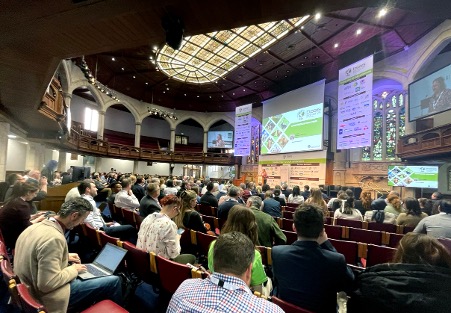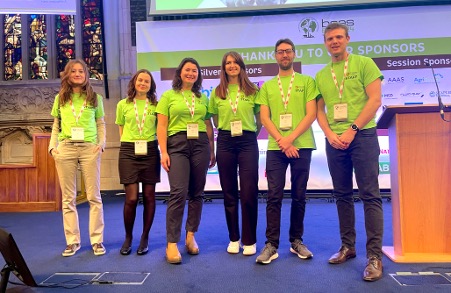Guest Blog: Livestock, ecosystems and the economy
In April 2024, the British Society of Animal Science (BSAS) held its 80th Annual Conference, in Belfast. The pivotal theme of this year’s event was the role of livestock in our ecosystems and economy. It inspired some deep discussions, which illustrate some of the directions that animal- based agriculture is heading.
Dr Lucy Ross, livestock specialist and sustainability consultant with Promar, was at the conference. Here, she debates of some of the key issues that emerged at that conference, in conversation with Dr Holly Vickery, from Harper Adams University.

Livestock and sustainability – is a balanced view possible?
Lucy Ross: Part of the issue is that it’s an easy subject to imagine and portray in the popular media: cows produce gas, so fewer cows = cleaner air, right? But it’s not that simple! While there’s no denying livestock’s impact on soil, water, and air, it’s important to get a complete picture.
As Professor Maggie Gill emphasized at BSAS24, we have a crucial need for responsibility, highlighting that every agricultural activity (in fact, any productive or manufacturing industry) leaves an impact, but issues are more nuanced than the simplistic media headlines suggest.
Holly Vickery: Farming, and the research that underpins it, acknowledges this responsibility and is actively addressing challenges.
For instance, excessive nutrient runoff remains a water-quality concern, and improved resource use and recycling are crucial. However, agricultural techniques are evolving rapidly, and solutions are being developed. Promising advancements, such as precision manure application and nitrogen-fixing crops, offer exciting possibilities for a more sustainable future.
Lucy Ross: I think we all need to better communicate the circular benefits of livestock, while pointing out that we can’t just provide singular solutions. Of course, popular media prefers polarising stories though, so the simple rather negative framing will likely continue.
Can livestock farming actually improve biodiversity?
Holly Vickery: Judging by discussions at BSAS24, many farms and researchers are exploring ways to integrate farming systems and pasture management, to create win-wins for livestock and the environment.
There’s awareness that livestock can be utilised to provide ecosystem benefits, particularly in mixed- farming models and there is enthusiasm for multi-disciplinary solutions, which consider the whole ecosystem.
Lucy Ross: One real-world challenge lies in creating a system that encourages different types of farms to link together on a regional basis. While nutrient cycling presents complexities, collaboration offers significant environmental benefits.
Holly Vickery: Some researchers, such as Dr Mary McEvoy are exploring the promise of diverse pastures for biodiversity, reduced emissions, and continued food production. However, those at BSAS 24 raised questions about how to apply this in their real-world situation, including:
- How do we select multi-sward varieties that are reliable for our specific conditions? (In other words, what suits my neighbour may not suit me, and why should I invest if there is no hard evidence of a solution’s applicability to my business?)
- How much difference does soil type and regional variation contribute to results?
- Most UK grassland is in the form of permanent pasture: how do we incorporate clover and multispecies into permanent pasture without ploughing?
Lucy Ross: Without doubt, further research will offer exciting possibilities, although challenges remain regarding soil type, fertility, longevity and management. Again, bridging the gap between research and real-world application will be crucial.
Academics, including Professor Bridget Emmett, UKCEH’s Science Area Head for Soils and Land Use, acknowledge the importance of balancing production with ecosystem services for true sustainability. In fact, UKCEH is building this type of solution into its products. Their tools and datasets help farmers visualize the environmental impact of their choices.
Can addressing soil health benefit producers as well as the environment?
Holly Vickery: Healthy soil is essential for a sustainable future. At BSAS 24, Dr Jack Hannam, President of the British Society of Soil Science, highlighted that up to 40% of UK agricultural land is degraded. However, practices like regenerative agriculture and innovative tools to aid grazing management are already reversing this trend.
Managed correctly, livestock can be hugely beneficial for soil health. For example, strategically managed grazing can improve nutrient cycling, soil biology, and carbon sequestration.
One way to help acknowledge these benefits and increase their use, would be to re-frame the idea of “profit”, so that it’s not just measured by yield, but includes rewards for enhancing environmental health, and other benchmarks such as social responsibility.
Lucy Ross: These are radical ideas, which may not attract a positive reaction in all quarters but do have a place if the preservation of productive environments is to be achieved. The path to success must include strengthening natural capital, soil health, and overall farm resilience.
Technology will play a key role in this. Automating data collection from farm equipment will help farmers make informed decisions and more targeted management, further reducing environmental impact. However, the way to harness this potential equitably remains unclear.
In short, a combined approach – adopting innovative technology and responsible practices – is key to unlocking the positive environmental potential of livestock farming. The challenge lies in finding a way to do this while still enabling farmers to farm. At Promar, this is what we are creating – a truly sustainable approach, which does not destroy farm business while enriching the environment that supports it.
Is carbon sequestration and carbon trading economically viable?
Holly Vickery: At BSAS24, soil carbon sequestration emerged as a key topic in carbon trading discussions. Experts emphasized the need for standardized methods and urgent action, despite uncertainties around soil behaviour and storage capacity.
Lucy Ross: Farmers raised a lot of interesting questions, such as querying soil’s carbon-storage limit and wondering about the potential of using biochar.
While biochar shows promise, a deeper understanding of soil profiles is needed for optimal placement. Further research will uncover the depth of its true potential.
What’s the future for the UK livestock industry?
Lucy Ross: The livestock industry’s contribution goes well beyond food production, that’s for sure, and presenters at BSAS24 were keen to point this out. [Livestock output was worth around £20 billion in 2022.] The industry also provides valuable co-products and ecosystem services that contribute significantly to our economy in other ways. These need to be appreciated too.
Holly Vickery: For me, BSAS24 underscored the need for science-based policies that consider the full picture of animal agriculture, including its environmental contributions. It also showcased the critical role livestock can play in achieving a sustainable circular food economy, through co-products utilized in various industries, and highlighting their role beyond food production.
However, in the face of constant trade pressures and changing consumer demands, the industry must be adaptable. Innovation is key to remaining competitive and to balancing economic viability with environmental responsibility.
How can change be achieved that benefits UK livestock farmers?
Lucy Ross: Farmers have a lot to say, and justifiably so, on the need for fairness in the supply chain. For example, James Taylor, a dairy and beef farmer in Portrush, articulated a widely held feeling among farmers. He highlighted the importance of clear and consistent communication with farmers from retailers, processors, researchers, and legislators, as consumer preferences and markets evolve.
Many farmers are in vulnerable positions in so many ways, bearing the brunt of environmental and economic pressures, while potentially being penalised by buyers for pursuing demonstrably eco-friendly practices such as selling sustainable food to local consumers.
Holly Vickery: To ensure sustainable change it is essential that we work collaboratively with farmers, research, industry, and policymakers to develop solutions that benefit all stakeholders, the economy, and the environment. Recognizing livestock’s multifaceted role in rural livelihoods and cultural heritage is another important element of appreciating their full societal value.
There’s a need to bridge the gap between research and farm
Lucy Ross: The agricultural research landscape is evolving rapidly due to new technologies, shifting consumer trends, and changing funding priorities. To keep pace, research needs to connect more effectively with real-world farming.
Holly Vickery: In academia, we’re always looking for ways to collaborate with farmers, to ensure the commercial applicability of our research and that strategies we investigate are feasible for use in the real-world.
Key to this is effective two-way communication, and a willingness for both parties to engage in on- farm research and collaboration that does not hamper farms’ needs to continue their commercial operations.
Lucy Ross: Farmers are receptive to practical improvements but require support to bridge the gap between research and implementation. Effective training, delivered efficiently, is also essential. At BSAS 24, farmers supported approaches such as discussion groups, development farms, and peer-to- peer learning led by trusted advisors.
In return, academic research needs to find models that enable research to be undertaken that does not compromise farmers’ needs to operate commercial ventures. Potential approaches here involve more long-term projects, greater use of passive data collection, and a greater willingness of all parties to share experience and knowledge in a collaborative environment.
Holly Vickery: By embracing technology, fostering collaboration, and prioritizing knowledge exchange, researchers can stay relevant and contribute to sustainable agriculture. This requires cooperation and a commitment to learning from each other. This is achievable, but requires good communication, good faith, and flexibility.
We also need to establish standardised ways of collecting and using data, and to solve the issue of ownership and compensation. It’s something that the whole supply chain needs to work out together.

What were the key take-aways from BSAS24?
Lucy Ross: Overall, it’s ensuring stakeholders come together to share knowledge, ideas and best practice, it helps participants at all points in the supply chain, and academics too, plot a path toward resilient and sustainable livestock farming, as well as targeted research. Opportunities to discuss the big issues in a neutral setting are vital.
Holly Vickery: Academic and research institutions are looking for ways to work effectively with farms, as they see that it will provide them with better results, and that farmers want robust evidence that new ideas are applicable and profitable to their needs. There is goodwill on both sides, but gaps still need to be bridged to enable efficient implementations.
Lucy Ross and Holly Vickery on the main messages of BSAS24:
- Diversity is strength – A one-size-fits-all approach doesn’t work. Farms can only thrive with tailored solutions, and learning from each other’s successes is crucial.
- Tech for transformation – From precision farming to soil analysis, technology empowers farmers to optimize resources and minimize their environmental impact. However, the future of data in farming remains an issue that, although promising, is still unattractive for many farmers due of lack of clarity about ownership, collection, compensation, or who exactly profits from it.
- Holistic harmony – Viable solutions prioritize biodiversity, conservation, and soil health alongside production. Embracing regenerative practices unlocks greater farm resilience. Integrating these approaches into policy is essential.
- Collaboration is key – Tackling complex challenges requires joint efforts. Regional partnerships and knowledge sharing between diverse farms bolster both environmental and economic sustainability.
- Research and trust – Collaborative research drives innovation, while consumer education builds trust. Highlighting livestock’s positive contributions to food security, livelihoods, and ecosystems is vital.
Promar – linking research and practice at all points in the supply chain
At Promar, we’re committed to helping all players in the agricultural industry. This includes finding ways to enhance environments and ecosystems while enabling farm businesses to thrive. We facilitate and enhance dialogues between different strands of the supply chain, bridge gaps between academia and industry, and help farms to successfully navigate the multiple challenges that they face.
Our unique perspective helps companies to obtain a complete picture quickly. If you have a project in mind, speak to us.
